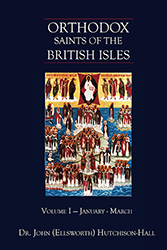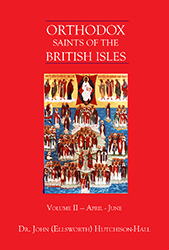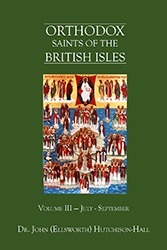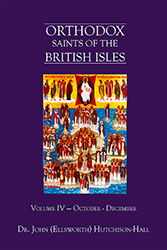
Orthodox Saints of the Pre-Schism
See of Rome
10th December (NS) — 27th November (OS) 2023
ACHARIUS, a monk at the Abbey of SS. Peter and Paul of Luxeuil (abbaye Saint-Pierre et Saint-Paul de Luxeuil) under St. Eustace (29th March) where he quickly became known for both his holiness of life as well as administrative skill. This reputation led him to be consecrated Bishop of Noyon-Tournai (present-day Belgium) in 621. As bishop, he was a great supporter of the work of St. Amandus of Maastricht (6th February), and was instrumental in having St. Omer named first Bishop of Thérouanne. St. Acharius reposed in 640.
APOLLINARIS, Abbot of Monte Cassino for eleven years, reposing 828.
BILHILD, widow of the Duke of Thuringia who, following the death of her husband, founded and served as first Abbess of Altmünster Abbey in Mainz. St. Bilhild reposed circa 710.
FACUNDUS and PRIMITIVUS, natives of Léon, who, are traditionally said to have been martyred during the reign of Diocletian (circa 300). However, it is more likely their martyrdom was in the mid-second century during the reign of Emperor Marcus Aurelius (r. 161–180).
FERGUS, an Irish bishop who went on a mission to Scotland with a group of clerics. Settling initially near Strogeath, near the River Earn in present-day Perth and Kinross, where St. Fergus and his companions established three churches in the area. Next, he evangelised Caithness where he established churches in Wick and Halkirk, and then to Aberdeenshire founding a church in present-day St. Fergus, and lastly, he founded a church in Glamis, Angus. St. Fergus reposed circa 730 and was initially buried in the church at Glamis. In the early sixteenth century, the Abbot of Scone had St. Fergus’ head translated and enshrined at Scone church.
GALLGO, (Sixth Century), founder of Llanallgo in Anglesey, Wales, was the brother of St. Eigrad (6th January) and De Excidio et Conquestu Britanniae author St. Gildas the Wise (29th January). He is believed to be buried on the site of the current St. Gallgo's Church near the village of Llanallgo.
JOHN ANGELOPTES, Bishop of Ravenna in Emilia-Romagna from 430 until his repose in 433. Some sources state he was also Metropolitan of Aemilia and Flaminia. According to tradition, he once had a vision of an angel assisting him at Divine Liturgy, hence the addition of Angeloptes which means 'the man who saw an angel' in Greek.
MAXIMUS of RIEZ, after being made Abbot of Lérins in 426, where he had received monastic tonsure, St. Maximus was consecrated Bishop of Reiz in 434, much against his will, by St. Hilary (5th May). St. Maximus reposed in 460.
SEACHNALL (SECHNALL, SECUNDINUS), according to the Irish Annals SS. Seachnall (Secundinus), Auxilius (his brother), and Iserninus (all three 6th December) came to Ireland in 439, to assist St. Patrick (17th March) in his evangelisation of the Irish. According to various sources, St. Seachnall was one of the sons of St. Patricks’ sister Darerca (22nd March ), and he may have studied in Gaul prior to accompanying St. Patrick to Ireland. Later tradition, of uncertain provenance, seems to intimate that Secundinus and Auxilius were of Italian origin, and several contemporary scholars have suggested that St. Seachnall was present in Ireland prior to St. Patrick’s arrival. The early Latin hymn, in praise of St. Patrick, known as Audite Omnes Amantes or the Hymn of Secundinus is attributed to St. Seachnall. St. Seachnall is the patron saint of, and traditionally considered the founder of, Domnach Sechnaill (present-day Dunshaughlin, Co. Meath), as well as the first Christian bishop to repose on Irish soil. St. Seachnall reposed after serving as a bishop for fourteen years, at the age of seventy-five (c. 447).
SEVERINUS, a hermit near Paris who reposed circa 540.
SIFFRED (SIFFREIN, SYFFROY, SUFFREDUS), a monk at Lérins and later Bishop of Carpentras in Provence, little else is known of his life. St. Siffred reposed circa 540 (some sources suggest 660). His relics are enshrined in the Cathedral of Saint Siffrein in Carpentras.
VALERIAN, an Archbishop of Aquileia in north-eastern Italy, who spent years fighting Arianism. St Valerian reposed 389.
VIRGILIUS (FERGAL), an Irishman who, while returning from a pilgrimage to the Holy Land, stopped in Bavaria, where he remained. He assisted St. Rupert (27th March) in his evangelisation of the area, served as Abbot of St Peter's in Salzburg, and in 765 was consecrated Bishop of Salzburg. St. Virgilius reposed in 784.
CARPOPHORUS and ABUNDIUS, St. Carpophorus, a priest and his deacon St. Abundius are amongst the many thousands who were martyred for the Faith during the Diocletianic Persecution (303–313). The location of their martyrdom, Rome, Spoleto, or possibly Seville, is the subject of debate.
DEUSDEDIT of BRESCIA, a Bishop of Brescia, and a key figure in the Councils against Monothelitism, reposing circa 679 - 700.
EULALIA, a young girl of only twelve or fourteen years of age, martyred in Mérida, during the Diocletianic Persecution (303–313).
GREGORY III, a native of Syria, whose reputation as a scholar was such, that the Romans elected him their bishop by acclimation. Serving as the ninetieth Pope of Rome from 731 until his repose in 741, St. Gregory was a vigorous opponent of iconoclasm, urging Byzantine Emperor Leo III to moderate his position during the first iconoclastic period (730 - 787), as well as convoking a synod at Rome in November 731 which condemned the heresy. Towards the end of his pontificate, St. Gregory also had to contend with threats from the Lombards.
GUITMARUS, the fourth Abbot of Saint-Riquier in present-day northern France. St. Guitmarus reposed circa 765.
HILDEMAR, Bishop of Beauvais in Picardy from 821 until his repose circa 844. Prior to his consecration as bishop, St. Hildemar was a monk at the Royal Abbey of St. Peter of Corbie (abbaye royale Saint-Pierre de Corbie) in Picardy (northern France).
JULIA of MÉRIDA, a fellow martyr with St. Eulalia (vide supra) in Mérida, circa 304.
MERCURIUS and COMPANIONS, a group of Roman soldiers who were escorting Christian prisoners to their place of execution. The prisoners made such an impression upon their guards, that the soldiers were baptised. Prisoners and guards were martyred together circa 300 in Lentini, Sicily.
MILTIADES thirty-second Pope of Rome from 311 until his repose in 314. Although St. Miltiades was pope when the Edict of Milan was declared by St. Constantine the Great (21st May) in 313, he is still venerated as a martyr on account of the suffering he endured during the reign of the Emperor Maximian (r. 286–305). He was also a force in the battle against Donatism, presiding over a Council in Rome (313) which condemned the heresy.
SINDULF (SINDULPHUS) of VIENNE, Bishop of Vienne, and strong proponent of monasticism in his diocese. St. Sindulf reposed circa 669.
Prior to the Schism the Patriarchate of Rome was Orthodox, and fully in communion with the Orthodox Church. As Saint John of Shanghai and San Francisco +1966 said “The West was Orthodox for a thousand years, and her venerable Liturgy is far older than any of her heresies”.
Details of British Saints excerpted from Orthodox Saints of the British Isles.
Details of continental saints from these sources.
In many cases there are several spelling versions of the names of saints from the British Isles. I use the Oxford Dictionary of National Biography version as the primary version with the more prevalent version in parenthesis e.g. Ceadda (Chad) of Lichfield.




